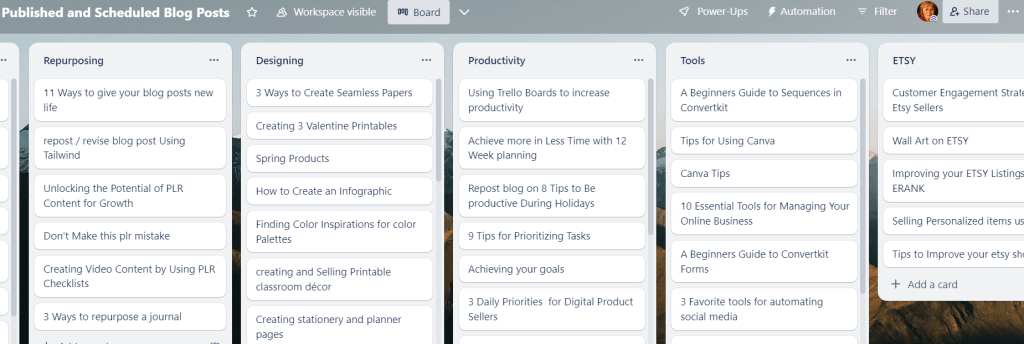When you start a business online creating content, many people start by producing blog posts on various topics to engage the reader. But what if I told you that your content creation journey doesn’t end there? Repurposing your existing blog posts can unlock new opportunities to reach and engage with your audience long term. And it will save time and energy and for some people it will be easier access.

Here are some easy ways to repurpose your content and provide you with practical tips on how to effectively extend their lifespan and amplify their impact.
Analyze and Assess Your Existing Blog Posts:
Before diving into the repurposing process, take some time to evaluate your existing blog posts and online content
. Identify the original content and decide if it is evergreen—topics that remain relevant and valuable over time. Also look at original content hat have performed exceptionally well in terms of search engine traffic, engagement, or shares. You can view the engagement by checking google analytics. These will serve as a solid foundation for repurposing efforts.
You might want to categorize your blog posts into excel, Airtable, Trello or any other organization tool you might use. Most of us write about certain topics and put a different spin on it each time. By organizing the content into different subjects, we can see where we are missing content, need to revise content and can add more interest. It also helps with creating a content calendar. Here the blog posts are organized by month:
And here the blog posts are organized by topic or subject. It is easy to see which topics I have used and which topics can be used in the future:

And here the blog posts are organized by topic or subject. It is easy to see which topics I have used and which topics can be used in the future:

You might also review those blog posts and see if anything has changed. Pinterest, Instagram and Tailwind especially change on a regular basis, so those blog posts are important, but we need to keep up with those changes. And if you are using those platforms, the good news is that you are already aware of many changes so it is an easy update for you.
Create New Formats:
One of the most effective ways to repurpose your blog posts is by transforming them into different formats. Consider the following options:
1) Infographics: Condense the key points, statistics, and visuals from your blog post into visually appealing infographics. Platforms like Canva or Piktochart can help you create professional-looking infographics even if you don’t have design experience. And it does double duty because you can use the infographic as a social media post such as Pinterest. Depending on the size, Pinterest uses the same vertical format as doe TikTok or Reels.

2) Videos: Leverage the popularity of video content by turning your blog posts into engaging video scripts or creating tutorials, online courses, summaries, or animated videos that bring your written content to life. YouTube, Vimeo, or social media platforms like Instagram and TikTok are excellent channels to share your video content.
3) Podcast Episodes: Convert your blog posts into podcast episodes by using the main ideas and insights as the basis for your discussions. Many content creators are using their content to launch podcasts to appeal to a large audience. You can invite guests or conduct interviews to add fresh perspectives and increase the value of the repurposed content.
You can also do this with videos you have created. Separate the video from the audio and save the audit for a different version. Just remember, if you are demonstrating something the audio only version will not have the same impact. One program you can use to separate and edit the audio is Tech Smith’s Audiate.
4) Slide Decks or Presentations: Utilize your blog post content to create slide decks or presentations that can be shared on platforms like SlideShare or LinkedIn. These visual aids can serve as valuable resources for educational or professional purposes.
5) Courses: Use the blog post as the basis for online courses. Or, combine several posts and use them as modules for a course. Especially if you have written multiple posts on the same specific topic over time , with different viewpoints, it is easy to combine into a training.
Expand and Update:
Another way to repurpose your blog posts is by expanding and updating them to provide a fresh perspective or additional insights. Consider the following strategies:
6) Write an eBook: Compile a series of related blog posts into an eBook. Expand on the content, add new examples, and refine your ideas to create a comprehensive resource that your audience can download or purchase. You can create an EBook easily with software like DESIGNRR. The additional plus is that Ebooks are a great way to get new subscribers by offering the content for their email address.
You can expand these EBooks instead of making them exactly the same as the original content. Create a step-by-step guide or workbook. Add checklists. Add todo lists. .
7) Develop a Series: If you have a long-form blog post, break it down into a series of shorter posts. This allows you to delve deeper into specific subtopics and engage your audience over a longer period.
The added benefit is that if you have a series of posts you can link to each other and that helps boost SEO. Google likes internal links and if you promote your blog posts, people like to keep tuning in to the next installment. And you can include affiliate links with the content as well. Just be sure they are evergreen topics.
8) Update with New Information: If you’ve published a blog post on a topic that has evolved or changed over time, revisit it and update it with the latest information. This helps you maintain the accuracy and relevance of your content, while also providing an opportunity to reintroduce it to your audience.
If you write about software, it is changing all the time. I originally wrote a post about using Tailwind last year. This year, new tools were added including a content marketing calendar in Tailwind. So I updated the original post and republished it with a video of the changes.
Repromote and Reshare:
Don’t let your repurposed content and hard work go unnoticed. Once you’ve created new formats or expanded your blog posts, it’s crucial to repromote and reshare them across various channels. Consider the following strategies:
9) Social Media: Share snippets, quotes, or key takeaways from your repurposed content on platforms like Twitter, Facebook, Instagram, or LinkedIn. Use compelling visuals, ask questions, and encourage engagement to drive traffic from social media accounts back to your repurposed content. This may encourage followers and visitors to check our new posts as well.

10) Email Marketing: Send newsletters or targeted emails to your subscribers, highlighting your repurposed content and explaining why it’s worth revisiting. Provide a clear call-to-action that directs readers back to the full content.
And if you are building your email list, an explanation might not be necessary. You will have new subscribers on your list who never saw the original post. And subscribers who were not ready for that information when you posted it the first time. The rule seems to be that people need to see the same information 7 times before they act on it or are ready for it, so don’t be shy about reposting.
11) Guest Contributions: Offer your repurposed content as guest contributions to other blogs or publications within your niche. This allows you to reach a new audience while establishing yourself as an expert in your field. It is a great way to build backlinks to your blog posts as well with will help with search engine optimization. Just make sure when you choose to contribute to other blogs that the audience is at least in part your target audience.
Repurposing your blog posts is a smart and efficient strategy to maximize your content’s reach and impact. By transforming your content into different formats, expanding and updating it, and actively repromoting it, you can extend the lifespan of your blog posts and engage with a wider audience. I use Missinglettr to post those blog posts to social media. In about 5 minutes, I can post 24 social media posts, giving me time to do other tasks.
And let’s not forget, when you repurpose your current content, you will appeal to a large audience who may prefer to listed or view the content instead of just reading.
Do you have any other strategies for repurposing content? Which of these tips might you use to repurpose your content? I would love to hear your thoughts. Drop a comment below or email me at [email protected]